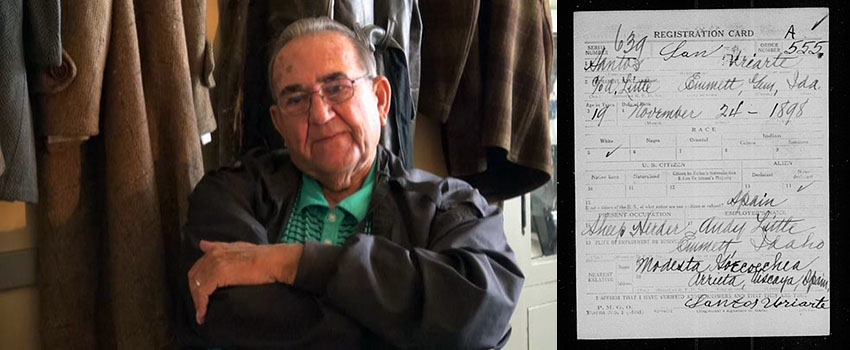
Tony Villanueva, interviewed by the Research Group. He is the son of Jose Villanueva, who was the contact for the Basque Government in Idaho. They moved to Emmett, from Boise, in 1936. (photos DACRP)
A community gathering took place in Emmett, Idaho on Monday afternoon, organized by Toni Berria, Patty Miller, Connie Urresti, and Carolyn Ruby. This Community Research Team is getting some important information about Basque families in Idaho and Oregon, from the beginning of the past century to the present days. “We want to create a comprehensive history,” said Berria in a conversation with EuskalKultura.com. “We want to know what brought them here, what they did… But, most importantly, we're going to ask them how they want to be portrayed.”
Boise, Idaho. Utilizing different sources, such as the LDS Family History Center, the Gem County Courthouse, and the Gem County Historical Museum, to name a few, the Community Research Team has found a considerable amount of information in the last months. But, before presenting it to the public, they want to double check it with the protagonists and their families. “It's their history, they lived it, so they should say what is really important and what is not. Also, they might be able to add significant information,” explained Toni Berria.
 Up to this point, the researchers have gathered information in Emmett and Barber, in Idaho, and in Jordan Valley and Burns, in the state of Oregon. In Jordan Valley and in Emmett, for example, they found over 900 and 400 Basque names, respectively. And, as the last newsletter from the Basque Museum and Cultural Center of Boise published, at the height of Barber’s existence, in the 1920s, Basque families made up almost 25 percent of the population.
Up to this point, the researchers have gathered information in Emmett and Barber, in Idaho, and in Jordan Valley and Burns, in the state of Oregon. In Jordan Valley and in Emmett, for example, they found over 900 and 400 Basque names, respectively. And, as the last newsletter from the Basque Museum and Cultural Center of Boise published, at the height of Barber’s existence, in the 1920s, Basque families made up almost 25 percent of the population.
At the moment, the team is trying to film as many testimonies as possible, while the elderly Basques that are still among us. Asked about the relevance of this work, Berria stated that “the older I get the more questions I wish I had asked my father or my grandmother.” In her words, the work is “for the future generations to know more, to understand the bigger picture.” And not only the next generations but, also, the protagonists are benefiting from this exercise: “A man we interviewed told me 'you made me think about things I hadn't thought about in years.”
The hope of the researchers is to be able to upload the information to a website and, later on, maybe create some information panels for the Basque Museum and even go to print.
-Anybody willing to share his/her stories and/or photographs can contact Patty Miller at pattyam@basquemuseum.com






 Up to this point, the researchers have gathered information in Emmett and Barber, in Idaho, and in Jordan Valley and Burns, in the state of Oregon. In Jordan Valley and in Emmett, for example, they found over 900 and 400 Basque names, respectively. And, as the last newsletter from the
Up to this point, the researchers have gathered information in Emmett and Barber, in Idaho, and in Jordan Valley and Burns, in the state of Oregon. In Jordan Valley and in Emmett, for example, they found over 900 and 400 Basque names, respectively. And, as the last newsletter from the  Send to a friend
Send to a friend Add comment
Add comment








